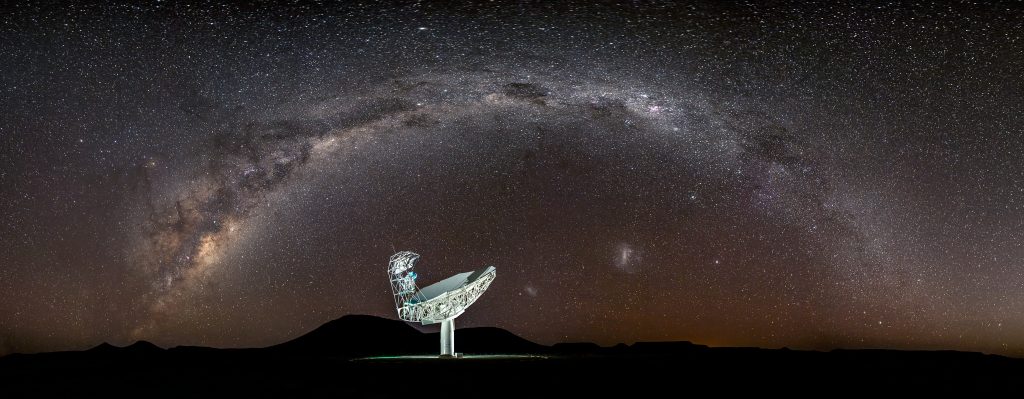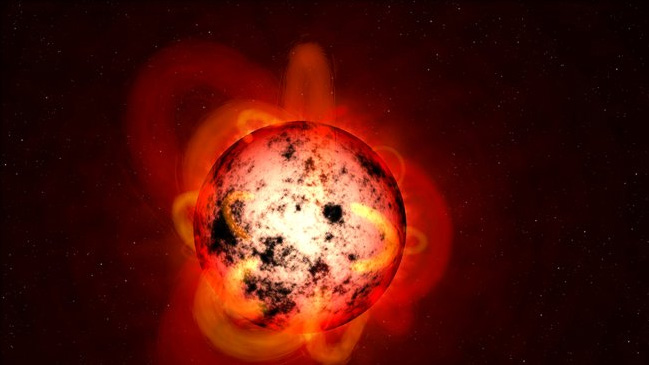
20 Nov MeerKAT and SALT combine to solve mystery stellar event
Scientists using the MeerKAT radio telescope and the Southern African Large Telescope have combined forces for the first time to discover and identify a unique and previously-unseen flare of radio emission from a binary star in our Galaxy.

South Africa has already demonstrated its excellent science and engineering skills by designing and building the MeerKAT radio telescope – as a pathfinder to the SKA. IThe 64-antenna array is located at the SKA site at Losberg in the Karoo, about 90 kilometres from Carnarvon. Credit: SARAO (South African Radio Astronomy Observatory).
The MeerKAT radio telescope in the Northern Cape of South Africa discovered the object which rapidly brightened by more than three times over a period of three weeks. This is the first new transient source discovered with MeerKAT and scientists hope it is just the tip of an iceberg of transient events to be discovered with the telescope in future.
Astronomers call an astronomical event “transient” when it lasts only for a short time, it may appear or disappear, or become fainter or brighter over seconds, days, or even years. These events are important as they provide a glimpse of how stars live, evolve, and die.
Using an assortment of telescopes around the globe, the researchers determined that the source of the flare is a binary system; where two objects orbit each other approximately every 22 days. While the cause of the flaring and the exact nature of the stars that make up the system is still uncertain, it is thought to be associated with an active corona – the hot outermost part of the brighter star.
The source of the observed activity is located in the Southern constellation of Ara and was found to be in the same place as a giant star about 2 times as massive as the Sun. The star’s orbital motion was discovered and measured using optical observations with the Southern African Large Telescope (SALT). Fortuitously, the star is sufficiently bright to have also been monitored by optical telescopes for the last 18 years and is seen to vary in brightness every three weeks, matching the orbital period.

The Southern African Large Telescope (SALT), the largest optical telescope in the Southern Hemisphere Credit: SAAO (South African Astronomical Observatory).
“This source was discovered just a couple of weeks after I joined the team, it was amazing that the first MeerKAT images I worked on had such an interesting source in them. Once we found out that the radio flares coincided with a star, we discovered that the star emits across almost the entire electromagnetic spectrum from X-ray to UV to radio wavelengths,” said Laura Driessen, a PhD student at The University of Manchester who led this work.
Patrick Woudt, Professor and Head of the Astronomy Department at The University of Cape Town said: “Since the inauguration in July 2018 of the South African MeerKAT radio telescope, the ThunderKAT project on MeerKAT has been monitoring parts of the southern skies to study the variable radio emission from known compact binary stars, such as accreting black holes.
“The excellent sensitivity and the wide field of view of the MeerKAT telescope, combined with the repeat ThunderKAT observations of various parts of the southern skies, allows us to search the skies for new celestial phenomena that exhibit variable or short-lived radio emission.”
Dr David Buckley from the South African Astronomical Observatory, who leads the SALT (Southern African Large Telescope) transient follow-up programme, which followed up on the discovery, commented: “This is a perfect example of where co-ordinated observations across different wavelengths were combined to give a holistic view of a newly discovered object.
“This study was one of the first to involve co-ordination between two of South Africa’s major astronomy facilities and shows the way for future such work.”
Professor Ben Stappers from The University of Manchester said: “The properties of this system don’t easily fit into our current knowledge of binary or flaring stars and so may represent an entirely new source class.”
The MeerKAT telescope is sweeping the sky for sources that vary on timescales from milliseconds to years, and will significantly improve human understanding of the variable radio sky. The discovery of this new transient with MeerKAT demonstrates how powerful this telescope will be in the search for further new transient events.
Rob Adam, Managing Director of the South African Radio Astronomy Observatory (SARAO) said: “Once again we see the potential of the MeerKAT telescope in finding interesting and possibly new astrophysical phenomena, as well as the power of the multi-wavelength approach to the analysis of observations.”
ENDS
Notes to Editors
This work was led by the ThunderKAT large Science Project and the European Research Council-funded MeerTRAP project (www.MeerTRAP.org), and the article on the MKT J170456.2-482100 can be found in the Monthly Notices of the Royal Astronomical Society. ThunderKAT is led by Professor Rob Fender at The University of Oxford and Professor Patrick Woudt at The University of Cape Town.
MeerTRAP is led by Professor Ben Stappers at The University of Manchester. The research team working on this project used the SARAO MeerKAT radio telescope array, together with many optical telescopes and instruments, including the Southern African Large Telescope (SALT), the HIPPO photopolarimeter on the South African Astronomical Observatory 1.9-m telescope, the Las Cumbres Observatory’s Network of Robotic Spectrographs, the All-sky Automated Survey, the Kilodegree Extremely Little Telescope and the All-Sky Automated Survey for Supernovae. Other multi-wavelength observations were also obtained from the Neil Gehrels Swift Observatory, an X-ray satellite and the Parkes radio telescope in Australia.
Contacts
David Buckley
PI SALT transient follow-up programme
South African Astronomical Observatory
dibnob@saao.ac.za
Patrick Woudt
Professor and Head of Department: Astronomy
University of Cape Town
pwoudt@ast.uct.ac.za
Laura Driessen
Astronomy PhD student
Department of Physics and Astronomy
University of Manchester
Laura.Driessen@Postgrad.Manchester.ac.uk
Ben Stappers
Professor of Astrophysics,
Department of Physics and Astronomy
University of Manchester
Ben.stappers@manchester.ac.uk
Background information
This work has been accepted to the Monthly Notices of the Royal Astronomical Society,
ArXiv (open-access) link to the article: https://arxiv.org/abs/1911.07713
As well as the MNRAS DOI: https://doi.org/10.1093/mnras/stz3027
The SALT observations reported in the paper, which gave detailed information on the orbital motion of the binary star, were obtained under a large science programme on transients. The Principal Investigator of this programme is Dr David Buckley.
Authors of the original paper in The Monthly Notices of the Royal Astronomical Society are: Laura Driessen, Iain McDonald, David Buckley, Manisha Caleb, Enrico Kotze, Stephen Potter, Kautubh Rajwade, Antonia Rowlinson, Ben Stappers, Evangelia Tremou, Patrick Woudt, Rob Fender, Richard Armstrong, Paul Groot, Ian Heywood, Assaf Horesh, Alexander van der Horst, Elmar Koerding, Vanessa McBride, James Miller-Jones, Kunal Mooley, and Ralph Wijers.
Laura, Manisha, Kaustubh and Ben are supported by a European Research Council (ERC) grant under the European Union’s Horizon 2020 research and innovation programme (grant agreement No 694745). Affiliations of the authors include:
- Jodrell Bank Centre for Astrophysics, Department of Physics and Astronomy, The University of Manchester, Manchester, M13 9PL, UK
- South African Astronomical Observatory, PO Box 9, Observatory 7935, South Africa
- Anton Pannekoek Institute, University of Amsterdam, Postbus 94249, 1090 GE, Amsterdam, The Netherlands
- Netherlands Institute for Radio Astronomy (ASTRON), Oude Hoogeveensedijk 4, 7991 PD, Dwingeloo, The Netherlands
- AIM, CEA, CNRS, Université Paris Diderot, Sorbonne Paris Cité, Université Paris-Saclay, F-91191 Gif-sur-Yvette, France
- Inter-University Institute for Data Intensive Astronomy, Department of Astronomy, University of Cape Town, Private Bag X3,Rondebosch 7701, South Africa
- Department of Physics, Astrophysics, University of Oxford, Denys Wilkinson Building, Keble Road, Oxford OX1 3RH, UK
- South African Radio Astronomy Observatory, 2 Fir Street, Black River Park, Observatory, Cape Town 7925, South Africa
- Department of Astrophysics/IMAPP, Radboud University Nijmegen, P.O. Box 9010, 6500 GL Nijmegen, The Netherlands
- Department of Physics and Electronics, Rhodes University, PO Box 94, Grahamstown 6140, South Africa
- Racah Institute of Physics, The Hebrew University of Jerusalem, Jerusalem 91904, Israel
- Department of Physics, The George Washington University, 725 21st Street NW, Washington, DC 20052, USA
- Astronomy, Physics and Statistics Institute of Sciences (APSIS), 725 21st Street NW, Washington, DC 20052, USA
- Department of Astronomy, University of Cape Town, Private Bag X3, Rondebosch 7701, South Africa
- IAU Office of Astronomy for Development, Cape Town, 7935, South Africa
- International Centre for Radio Astronomy Research — Curtin University, GPO Box U1987, Perth, WA 6845, Australia
- Department of Physics, University of Oxford, Keble Road, Oxford OX1 3RH, UK
- National Radio Astronomy Observatory, Socorro, NM 87801, USA
- Caltech, 1200 E. California Blvd. MC 249-17, Pasadena, CA 91125, USA
- Southern African Large Telescope, P.O.Box 9, Observatory, 7935, South Africa
Further information (links)
- MeerKAT telescope: https://www.ska.ac.za/science-engineering/meerkat/about-meerkat/
- SALT telescope: https://www.salt.ac.za/
- HIPPO photopolarimeter: https://www.saao.ac.za/science/facilities/instruments/hippo/
- Neil Gehrels Swift Observatory: https://swift.gsfc.nasa.gov/
- Las Cumbres Observatory Network of Robotic Spectrographs: https://lco.global/observatory/instruments/nres/
- All-sky Automated Survey: https://www.astrouw.edu.pl/asas/
- Kilodegree Extremely Little Telescope: https://keltsurvey.org/
- All-Sky Automated Survey for Supernovae: https://www.astronomy.ohio-state.edu/asassn/index.shtml
- Parkes Observatory: https://www.parkes.atnf.csiro.au/
- SARAO: https://www.ska.ac.za/about/sarao/
- SAAO: https://www.saao.ac.za/
- Jodrell Bank Centre for Astrophysics, the University of Manchester: https://www.jodrellbank.manchester.ac.uk/
- The University of Oxford, Department of Physics: https://www2.physics.ox.ac.uk/research/astrophysics
- The University of Cape Town, Department of Astronomy: https://www.ast.uct.ac.za/
Illustrations

Artists conception of an active star
Contacts
David Buckley PI SALT transient follow-up programme South African Astronomical Observatory dibnob@saao.ac.za Patrick Woudt Professor and Head of Department: Astronomy University of Cape Town pwoudt@ast.uct.ac.za
